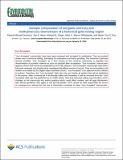Files in this item
Isotopic composition of inorganic mercury and methylmercury downstream of a historical gold mining region
Item metadata
| dc.contributor.author | Donovan, Patrick | |
| dc.contributor.author | Blum, Joel | |
| dc.contributor.author | Singer, Michael Bliss | |
| dc.contributor.author | Marvin-DiPasquale, Mark | |
| dc.contributor.author | Tsui, Martin | |
| dc.date.accessioned | 2017-01-21T00:32:14Z | |
| dc.date.available | 2017-01-21T00:32:14Z | |
| dc.date.issued | 2016-01-20 | |
| dc.identifier | 240467391 | |
| dc.identifier | a2ca475c-be8b-43ea-a5a7-6c9543e6f7c1 | |
| dc.identifier | 84958279151 | |
| dc.identifier | 000370454200008 | |
| dc.identifier.citation | Donovan , P , Blum , J , Singer , M B , Marvin-DiPasquale , M & Tsui , M 2016 , ' Isotopic composition of inorganic mercury and methylmercury downstream of a historical gold mining region ' , Environmental Science and Technology , vol. 50 , no. 4 , pp. 1691–1702 . https://doi.org/10.1021/acs.est.5b04413 | en |
| dc.identifier.issn | 0013-936X | |
| dc.identifier.uri | https://hdl.handle.net/10023/10141 | |
| dc.description | The authors acknowledge financial support from the National Science Foundation: EAR-1225630 (to J.D.B.) and EAR-1226741 (to M.B.S.). | en |
| dc.description.abstract | We measured total mercury (THg) and monomethyl mercury (MMHg) concentrations and mercury (Hg) isotopic compositions in sediment and aquatic organisms from the Yuba River (California, USA) to identify Hg sources and biogeochemical transformations downstream of a historical gold mining region. Sediment THg concentrations and δ202Hg decreased from the upper Yuba Fan to the lower Yuba Fan and the Feather River. These results are consistent with the release of Hg during gold mining followed by downstream mixing and dilution. The Hg isotopic composition of Yuba Fan sediment (δ202Hg = −0.38 ± 0.17‰ and Δ199Hg = 0.04 ± 0.03‰; mean ± 1 SD, n = 7) provides a fingerprint of inorganic Hg (IHg) that could be methylated locally or after transport downstream. The isotopic composition of MMHg in the Yuba River food web was estimated using biota with a range of %MMHg (the percent of THg present as MMHg) and compared to IHg in sediment, algae, and the food web. The estimated δ202Hg of MMHg prior to photodegradation (−1.29 to −1.07‰) was lower than that of IHg and we suggest this is due to mass-dependent fractionation (MDF) of up to −0.9‰ between IHg and MMHg. This result is in contrast to net positive MDF (+0.4 to +0.8‰) previously observed in lakes, estuaries, coastal oceans, and forests. We hypothesize that this unique relationship could be due to differences in the extent or pathway of biotic MMHg degradation in stream environments. | |
| dc.format.extent | 1575853 | |
| dc.language.iso | eng | |
| dc.relation.ispartof | Environmental Science and Technology | en |
| dc.subject | GE Environmental Sciences | en |
| dc.subject | NDAS | en |
| dc.subject.lcc | GE | en |
| dc.title | Isotopic composition of inorganic mercury and methylmercury downstream of a historical gold mining region | en |
| dc.type | Journal article | en |
| dc.contributor.institution | University of St Andrews. Earth and Environmental Sciences | en |
| dc.contributor.institution | University of St Andrews. Scottish Oceans Institute | en |
| dc.identifier.doi | https://doi.org/10.1021/acs.est.5b04413 | |
| dc.description.status | Peer reviewed | en |
| dc.date.embargoedUntil | 2017-01-20 | |
| dc.identifier.url | http://pubs.acs.org/doi/suppl/10.1021/acs.est.5b04413 | en |
This item appears in the following Collection(s)
Items in the St Andrews Research Repository are protected by copyright, with all rights reserved, unless otherwise indicated.

